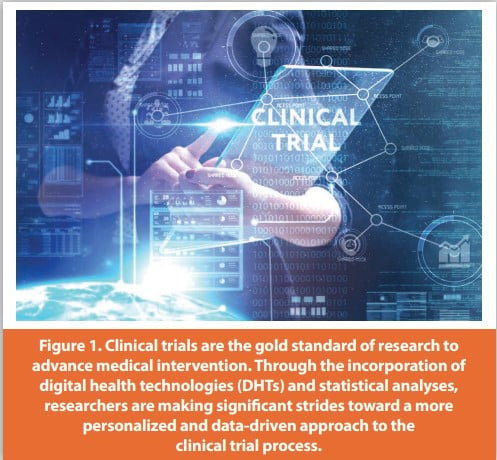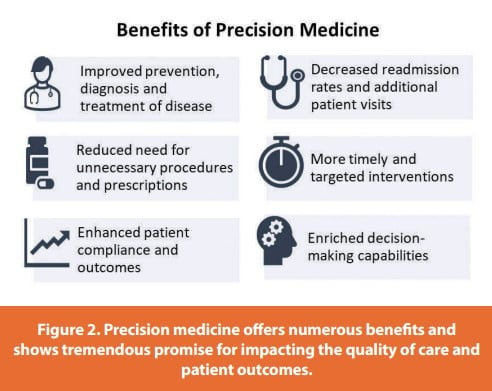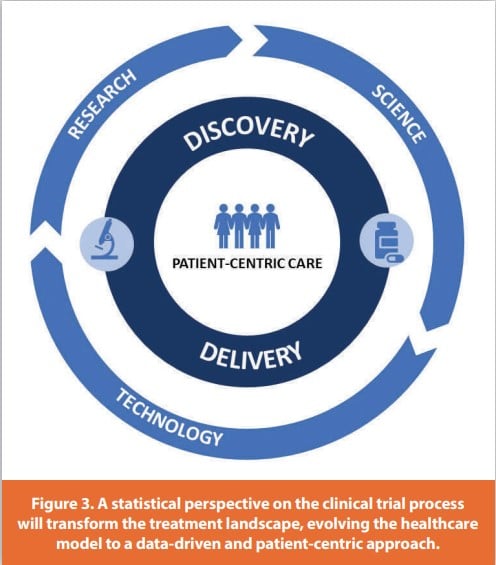Worldwide, precision medicine treatment spending was almost $32 billion in 2022. By 2027, that number is expected to reach more than $124 billion.1 This increase underscores the growing emphasis on providing more personalized treatment and individualized patient interventions. Clinical trials are considered the gold standard in research to further evaluate the safety and efficacy of medical intervention. Through the incorporation of digital health technologies (DHTs), researchers are making significant strides toward a more personalized and data-driven approach to the clinical trial process. This complex interplay of patient data and statistical insights enables precision medicine, which is centered upon a personalized approach and holds tremendous promise to make patient care more effective and efficient in terms of time, resources, and cost.
Oncology, for example, is just one area in which this potential is already being realized and where precision medicine is impacting clinical research. A team, including Texas University MD Anderson Cancer Center researchers, detailed how traditional oncology practice “relies on average-population-benefit decisions, often derived from randomized clinical trials of unselected patients, which have been the cornerstone of drug approvals for decades.”2 Therapy decisions were (and primarily still are) ordinarily based on the tumor’s origin, the authors noted, adding that precision oncology “depends on data from trials selecting patients based on their genomic/biologic/immune markers.”2 As such, some clinical studies are now based on mutation status, as opposed to where in the body the tumor originated.

Researchers can customize medical interventions with statistical analyses aided by precision medicine, ensuring treatments align precisely with individual patient characteristics. Statistics serve as the guiding force, unraveling patterns and correlations within the vast amount of data to enable the potential to personalize healthcare.
Take pattern recognition, for example. Statistical methods are used to analyze large datasets, such as genomics, proteomics, and clinical records, to reveal trends and patterns within the data. These patterns could include genetic variations, biomarker expressions, or other variables that affect the patient’s health or disease status. Statistical techniques also help pinpoint correlations between specific variables, and advanced statistical analysis can enable the exploration of links between genetic mutations, environmental factors, and disease outcomes.
Regarding predictive modeling, statistical models—including machine learning (ML) algorithms—rely on patient-specific characteristics to help predict disease risk, progression, and treatment response. Predictive modeling also enables healthcare providers to anticipate health issues a patient might experience and adapt strategies accordingly.
The Promise of Precision Medicine
Historically, medical treatment has taken a one-size-fits-all approach that doesn’t necessarily account for specific differences between patients—genetics, lifestyle, and environmental factors, for instance. Also referred to as personalized medicine, precision medicine takes a different, if not opposite, approach. It uses just this type of information to classify patients into subpopulations and guide decisions regarding their medical management. The U.S. National Human Genome Research Institute has defined precision medicine as “an innovative approach that uses information about an individual’s genomic, environmental, and lifestyle information to guide decisions related to their medical management.”3 Leslie G. Biesecker, MD, director and a National Institutes of Health distinguished investigator at the Center for Precision Health, stated that the goal of precision medicine is to use that information to enable a more precise approach for preventing, diagnosing, and treating disease. “It is common sense that no two individuals are the same, and so they should not get the same healthcare,” said Dr. Biesecker. “Precision healthcare embodies that simple idea.”4
Precision medicine shows tremendous promise for impacting the quality of care and patient outcomes. Then-President Barack Obama outlined some of the benefits this approach offers in a 2015 address announcing the launch of the Precision Medicine Initiative. This was an “all of government” effort designed to tap the expertise within federal government agencies to usher in a new era of more individualized medicine through research, technology, and policies. “The future of precision medicine will enable healthcare providers to tailor treatment and prevention strategies to people’s unique characteristics, including their genome sequence, microbiome composition, health history, lifestyle, and diet,” stated the initiative.5

Precision medicine is already showing its utility in areas such as cancer care. According to the American Cancer Society (ACS), physicians rely on personalized medicine to guide their treatment plans for cancer patients, using precision medicine to determine which tests and treatment options are most appropriate.6 Precision medicine can help physicians identify individuals at high-risk for cancer, make correct diagnoses of certain types of cancer earlier, determine which cancer treatment options are best, and assess the effectiveness of a given treatment course. Testing cancer cells for specific gene or protein changes or biomarkers can impact options for treating some types of cancer. As noted by ACS, “this is often what people mean when they refer to ‘precision medicine.”6
The benefits of this type of tailored approach are numerous. For example, personalized medicine reduces the need for readmission and additional patient visits. Because precision medicine utilizes genetic and other demographic factors, initial tests are generally more accurate. Subsequently, patients receiving personalized medicine can typically avoid additional, unnecessary procedures and prescriptions. As such, precision medicine has the potential to be a cost-effective alternative to more traditional treatment. While the approach entails costly steps initially, such as high-tech diagnostic tests, the increased accuracy of these tests means that patients may be able to avoid further unnecessary procedures and prescriptions. Such benefits boost the efficiency of physicians and healthcare teams by reducing the need to adjust prescriptions and treatment plans.
Machine Learning’s Role in Aiding Precision Medicine
ML will play a role in the realization of precision medicine’s potential to move away from a one-size-fits-all approach to developing patient treatment plans. Researchers predicted that “the convergence of artificial intelligence (AI) and precision medicine promises to revolutionize healthcare.”7 One of precision medicine’s primary benefits is its ability to use advanced computation to help physicians identify the phenotypes of patients with unique needs and those who might respond to treatment differently than similar patients and assist clinicians in making care decisions based on that information.
ML’s capability to handle “large and complex datasets makes them suitable for applications in precision medicine.”7 Specifically, the use of ML can expand applications of feedback control to “direct the response of complex biological systems predictability and automatically,” according to the investigators, adding that this capability “paves the way” for more sophisticated treatments that adapt to the patient’s response. Additionally, elements of control that can be improved through ML include sensor data analysis, modeling, and methods of reconfiguring the control algorithm “on the fly.”8
From an efficiency standpoint, the real-time analysis of patient data enabled by ML aids clinicians in making informed decisions in a timelier fashion and helps better predict disease risks and outcomes, transforming early intervention and preventive strategies. Applying ML in drug development also accelerates the identification of potential therapeutic targets and streamlines the drug discovery process.
ML has the potential to revolutionize early intervention and preventive strategies. For example, ML can be a tremendous asset in devising risk prediction and stratification approaches. ML algorithms analyze patient data to predict patients’ risk of developing specific diseases. By stratifying individuals based on their risk profiles, clinicians can prioritize preventive measures for those at higher risk and subsequently facilitate early intervention to mitigate or delay the onset of disease.
ML models are proficient at identifying subtle patterns and irregularities from diverse datasets. This capability improves clinicians’ ability to detect and diagnose diseases earlier by analyzing biomarkers, imaging data, and other clinical information. This translates to more timely and targeted interventions before the disease progresses.
The real-time monitoring of patient data that ML facilitates allows healthcare professionals to identify subtle changes in health status.
Using this evolving data, clinicians can put adaptive interventions in place and ensure that treatment plans are adjusted promptly to respond to changes in a patient’s condition. ML models can also predict patient engagement and behavior, assessing patient preferences and adherence patterns, for instance, to predict how a patient might respond to various interventions. This information is valuable to clinicians who can design personalized preventive strategies and interventions that fit specific patient preferences and motivations.
On a broader scale, healthcare systems rely on ML to analyze population health data, uncovering trends, patterns, and areas of concern. Understanding the risks and factors that contribute to disease at the population level is crucial because it helps healthcare providers implement targeted preventive measures and public health interventions.
Clinicians use ML to analyze medical image data gleaned from MRIs, computed tomography scans, and X-rays to detect early signs of disease, quantify its progression, and gain insight to design more personalized treatment plans.
Challenges and Considerations
There are challenges associated with the adoption of precision medicine, such as cost considerations. While precision medicine techniques decrease the need for additional appointments and diagnostic tests, the initial costs of genetic testing, for instance, can be significant and might prohibit some patients from receiving more personalized treatment.
Precision medicine is not yet widely accessible, nor are all physicians well-versed in how to deliver more personalized treatment. These factors could equate to limited availability for some patients, such as those outside urban or suburban areas or without the financial resources to travel for treatment. Given its limited accessibility, there is a lack of standardization in precision medicine, which can make comparing patient treatments and outcomes problematic and determining the most effective treatment for a patient more challenging.
Ethical issues could also arise as precision medicine becomes more commonplace. Genetic tests can divulge sensitive patient health information that could be used by third parties to discriminate against a patient seeking employment or insurance coverage, for example. Compliance with evolving regulations and standards related to the ethical use of patient data and emerging technologies associated with precision medicine adds additional difficulty for clinicians. Other concerns include data complexity and the intricate and diverse datasets encompassing genetic, clinical, and environmental factors.
There are interoperability issues to overcome to successfully integrate data from various healthcare systems and sources, which is necessary to create in-depth patient profiles that help inform clinicians’ treatment plans. For instance, a dearth of standardized formats for sharing and exchanging healthcare data can hamper interoperability. In addition, disparate healthcare systems and platforms often rely on different data structures, which impedes seamless data integration. Integrating precision medicine’s tools and technologies into existing healthcare systems and workflows is a complex process, but achieving compatibility and interoperability between different technologies is critical if clinicians wish to implement them successfully.

Bridging the gap between scientific and clinical practice presents another barrier, as healthcare providers may face difficulties incorporating precision medicine into their workflows. Integrating data from various sources, such as electronic health records (EHRs), genomic databases, and wearable devices, can present challenges in creating unified and comprehensive patient profiles. Making precision medicine approaches part of routine clinical practice can also disrupt well-established workflows.
These hurdles can be overcome. The complexity of genetic, clinical, and environmental data associated with precision medicine requires sophisticated analytical methods, and analyzing and interpreting large datasets with diverse variables means adopting computational techniques and expertise. Education and training are necessary to give healthcare professionals an understanding of precision medicine tools and technologies. Clinicians will want to see plenty of evidence and validation of precision medicine interventions before fully incorporating them into patient care.
These challenges underscore the complex nature of precision medicine. Addressing these potential issues will require researchers, healthcare providers, policymakers, and technology providers to work together to overcome regulatory challenges and ensure precision medicine is integrated into patient care effectively and ethically.
Ultimately, statistics are pivotal in unraveling the unique genetic, environmental, and lifestyle factors influencing individual health. This statistical perspective transforms the treatment landscape, allowing healthcare to evolve from a one-size-fits-all model to a nuanced, tailored approach, creating a paradigm shift in how medical care is viewed and delivered. It’s a journey into the future of healthcare, where statistical precision becomes the cornerstone in developing more effective, targeted, and patient-focused interventions, heralding a new era in the evolution of medical research.
References
- Statista. Total precision medicine treatment spending worldwide from 2022 to 2027. Available at https://www.statista.com/statistics/1420946/spending-on-precision-medicine-treatments-globally/. Accessed February 12, 2024.
- Zlobina K, Jafari M. The role of machine learning in advancing precision medicine with feedback control. Cell Rep Phys Sci. 2022; 3(11):101-149.
- Delpierre C, Lefevre T. Precision and personalized medicine: What their current definition says and silences about the model of health they promote. Implication for the development of personalized health. Front Sociol. 2023; 8:1112-1159.
- National Human Genome Research Institute (NHGRI). Precision medicine definition. Available at https://www.genome.gov/genetics-glossary/Precision[1]Medicine#:~:text=Precision%20medicine%20(generally%20considered%20 analogous,related%20to%20their%20medical%20management. Accessed January 30, 2024.
- The White House, President Barack Obama. The Precision Medicine Initiative information page. Available at https://obamawhitehouse.archives.gov/precision-medicine. Accessed Jan. 30, 2024.
- American Cancer Society. Precision or personalized medicine information page. Available at https://amp.cancer.org/cancer/managing-cancer/treatment-types/precision-medicine. html. Accessed Jan. 29, 2024.
- Johnson K, Wei WQ. Precision Medicine, AI, and the Future of Personalized Health Care. Clin Transl Sci. 2021; 14(1):86-93.
- Zlobina K, Jafari M. The role of machine learning in advancing precision medicine with feedback control. Cell Rep Phys Sci. 2022; 3(11):101-149.
Author Details
Shivashankar Thati, M.S., GSTAT, Statistical Analyst -TechData Service Company, LLC
Shivashankar Thati, M.S., GSTAT, is a clinical statistical analyst specializing in clinical trials and new drug development. Shivashankar holds a master’s degree in chemistry from Texas A&M University and is working on a second master’s degree in applied statistics at Villanova University. His contributions to the industry have been recognized by numerous organizations, publications, and universities. For more information, contact [email protected].
Publication Details
This article appeared in American Pharmaceutical Review:Vol. 27, No. 2March 2024Pages: 24-27
Subscribe to our e-Newsletters
Stay up to date with the latest news, articles, and events. Plus, get special
offers from American Pharmaceutical Review delivered to your inbox!
Sign up now!